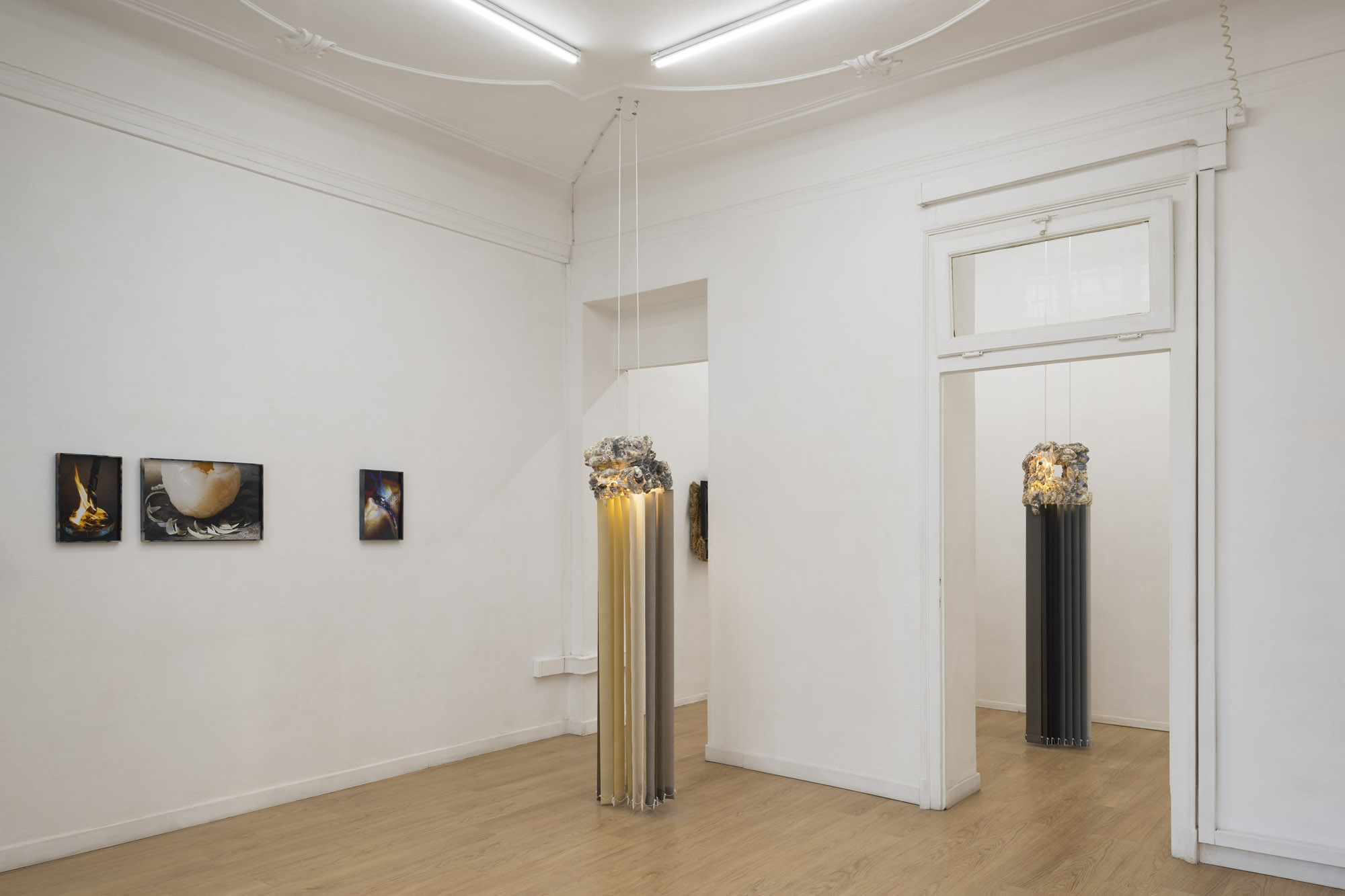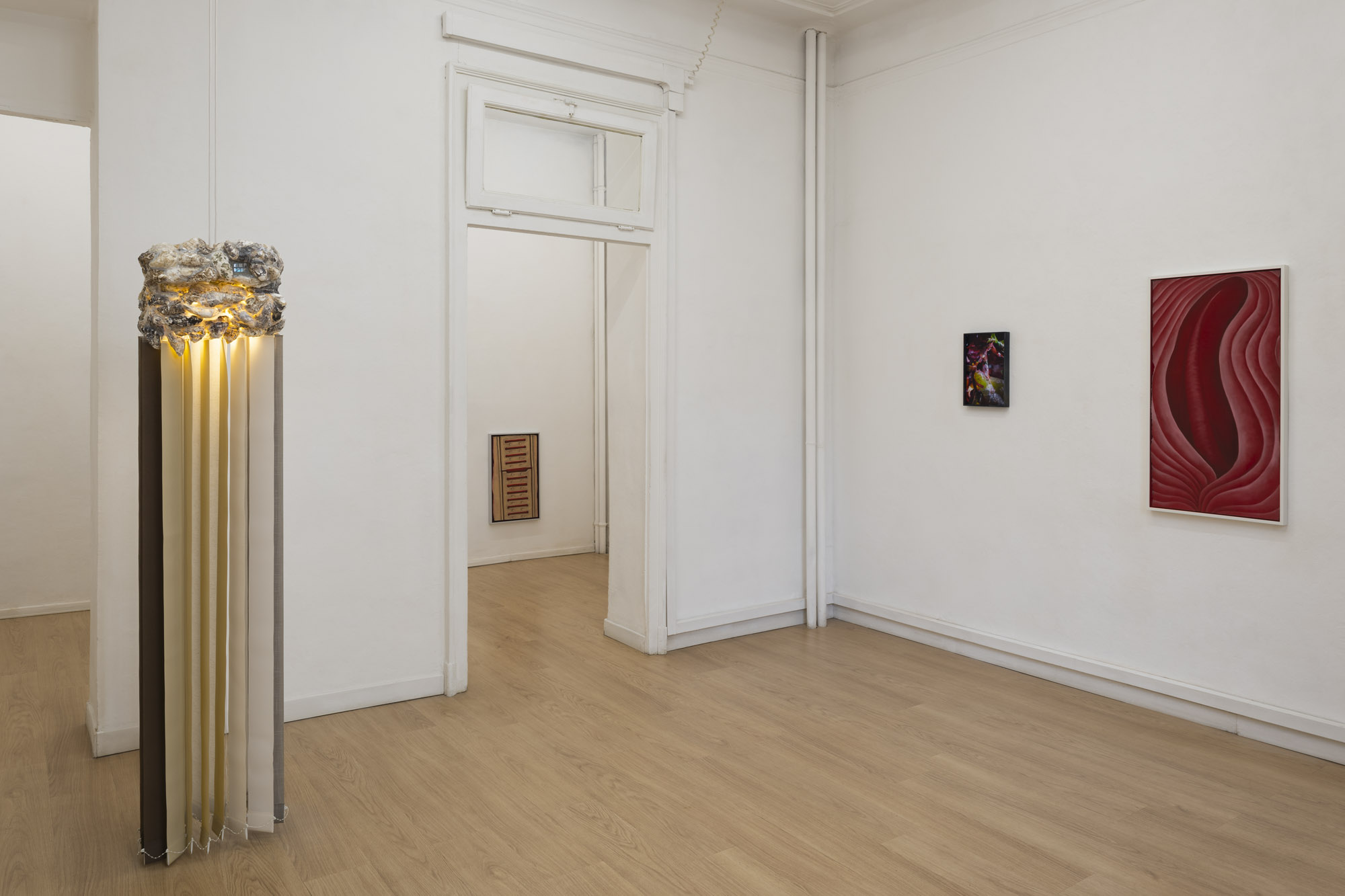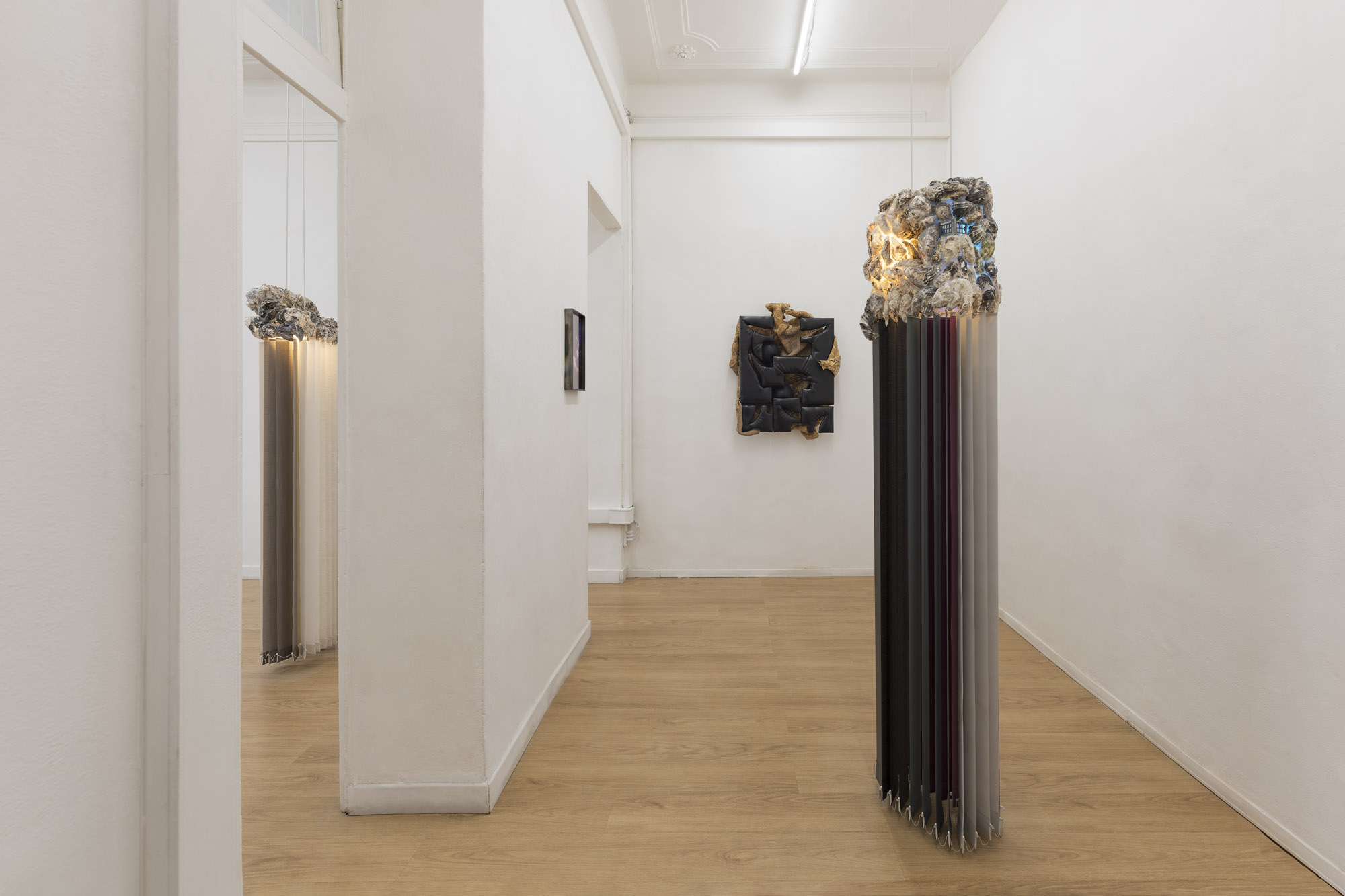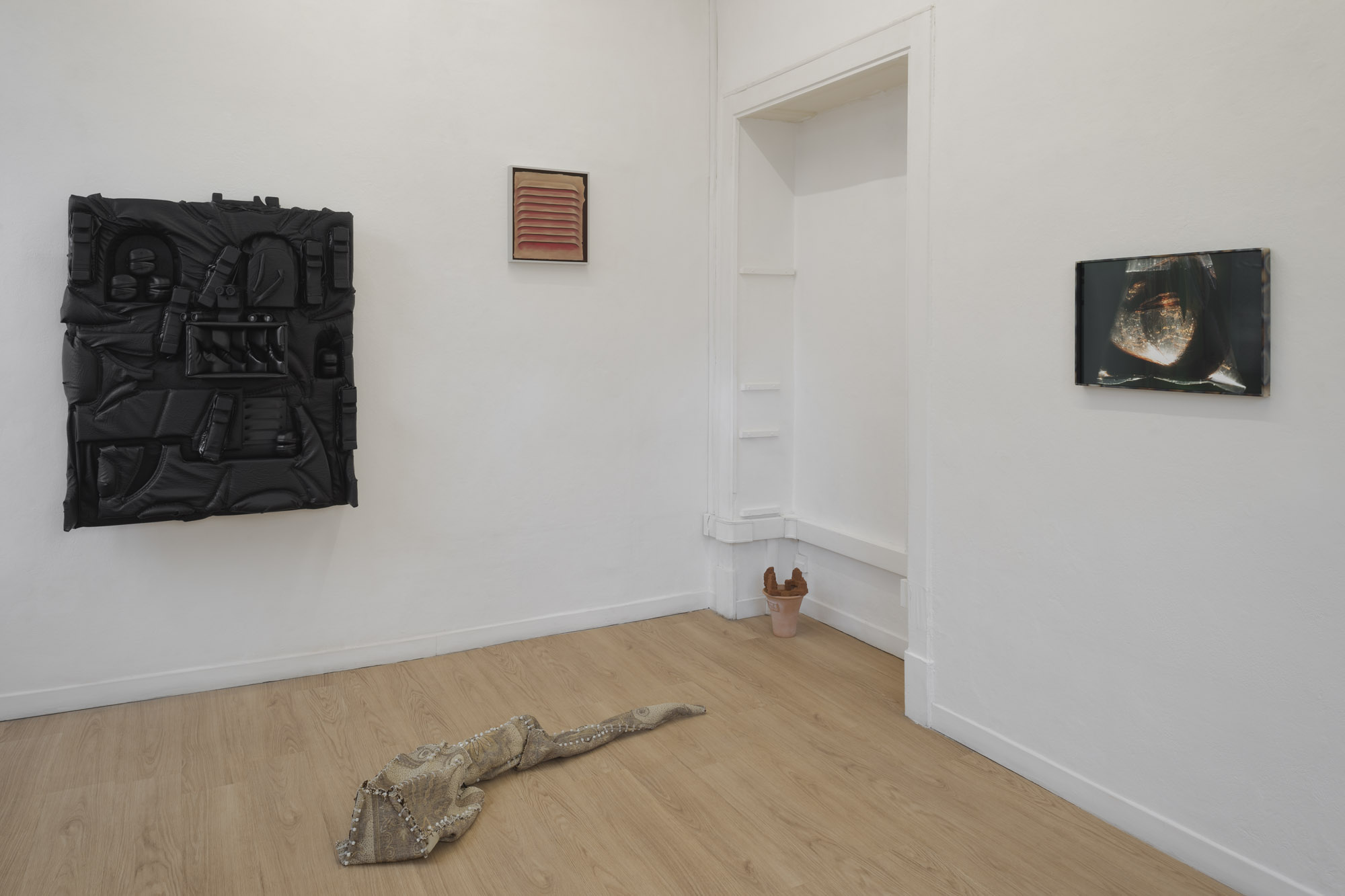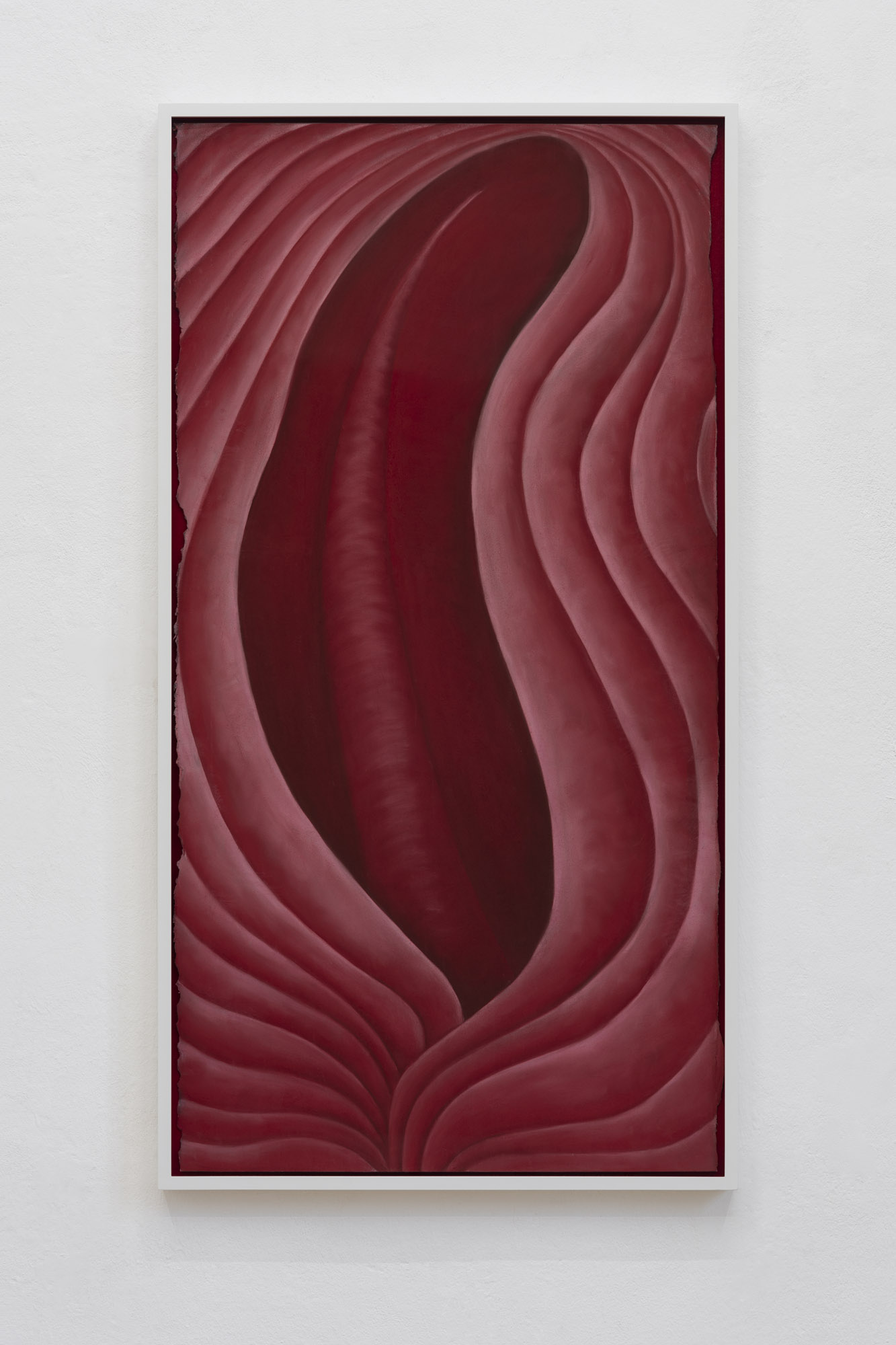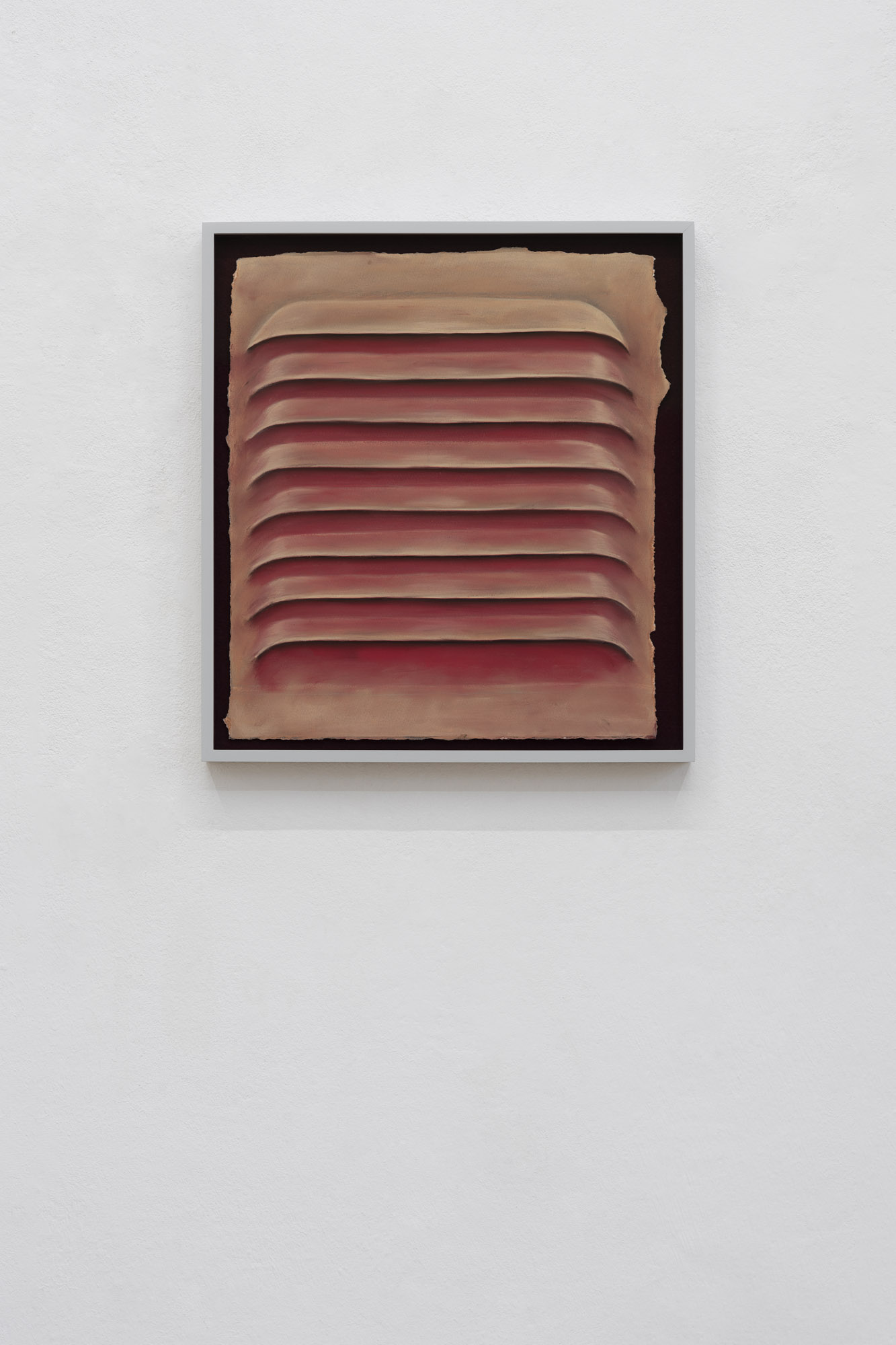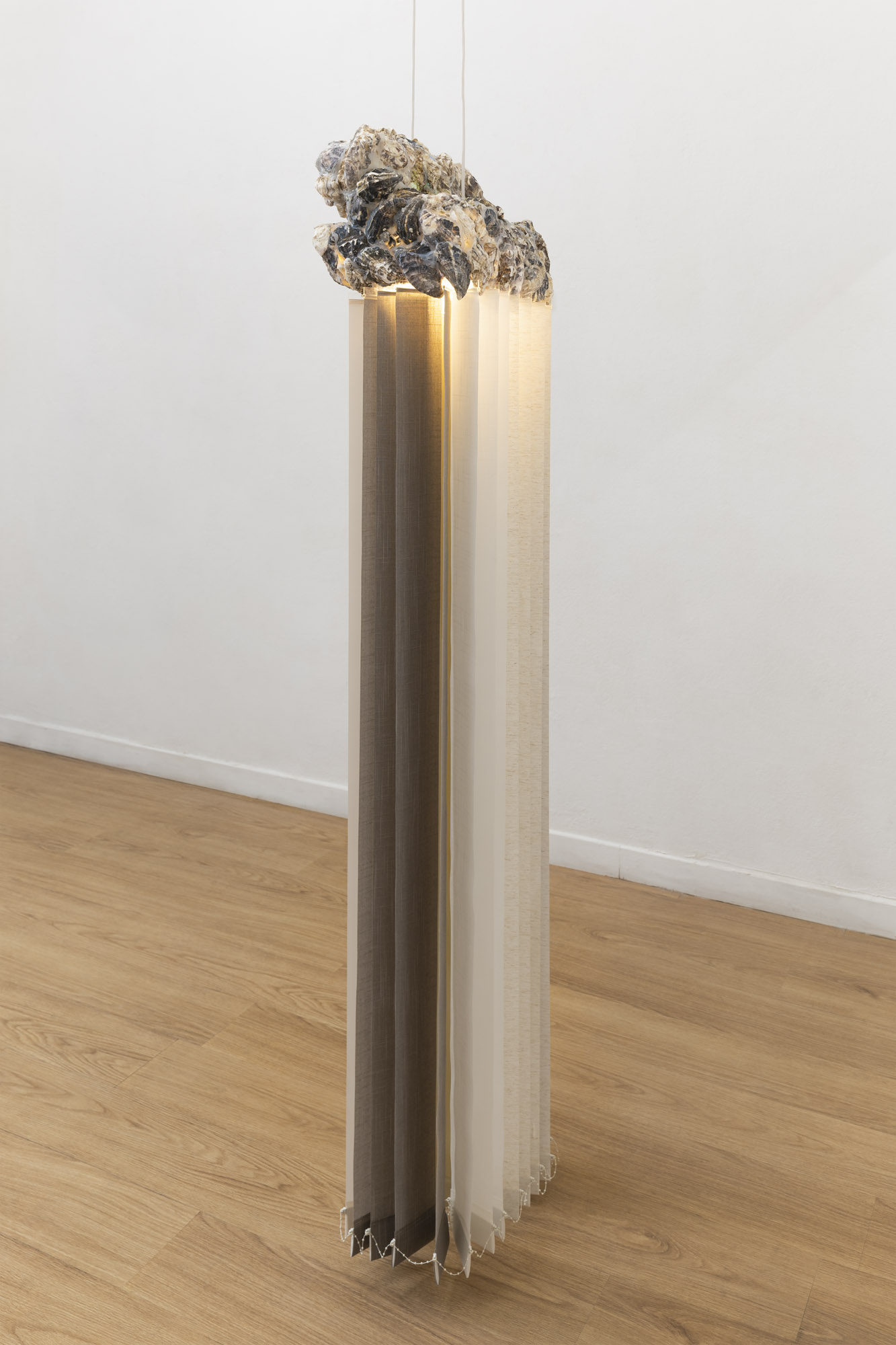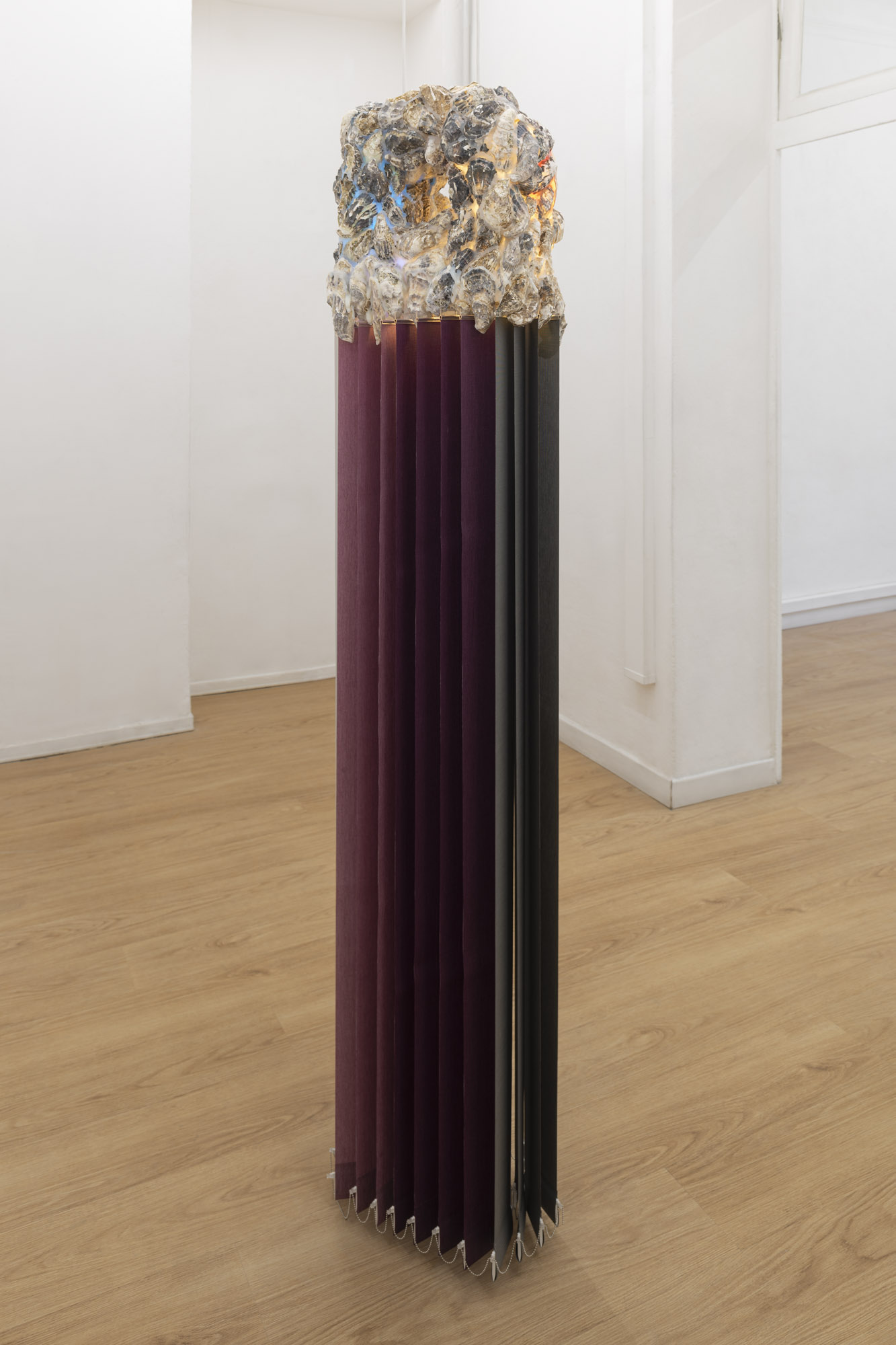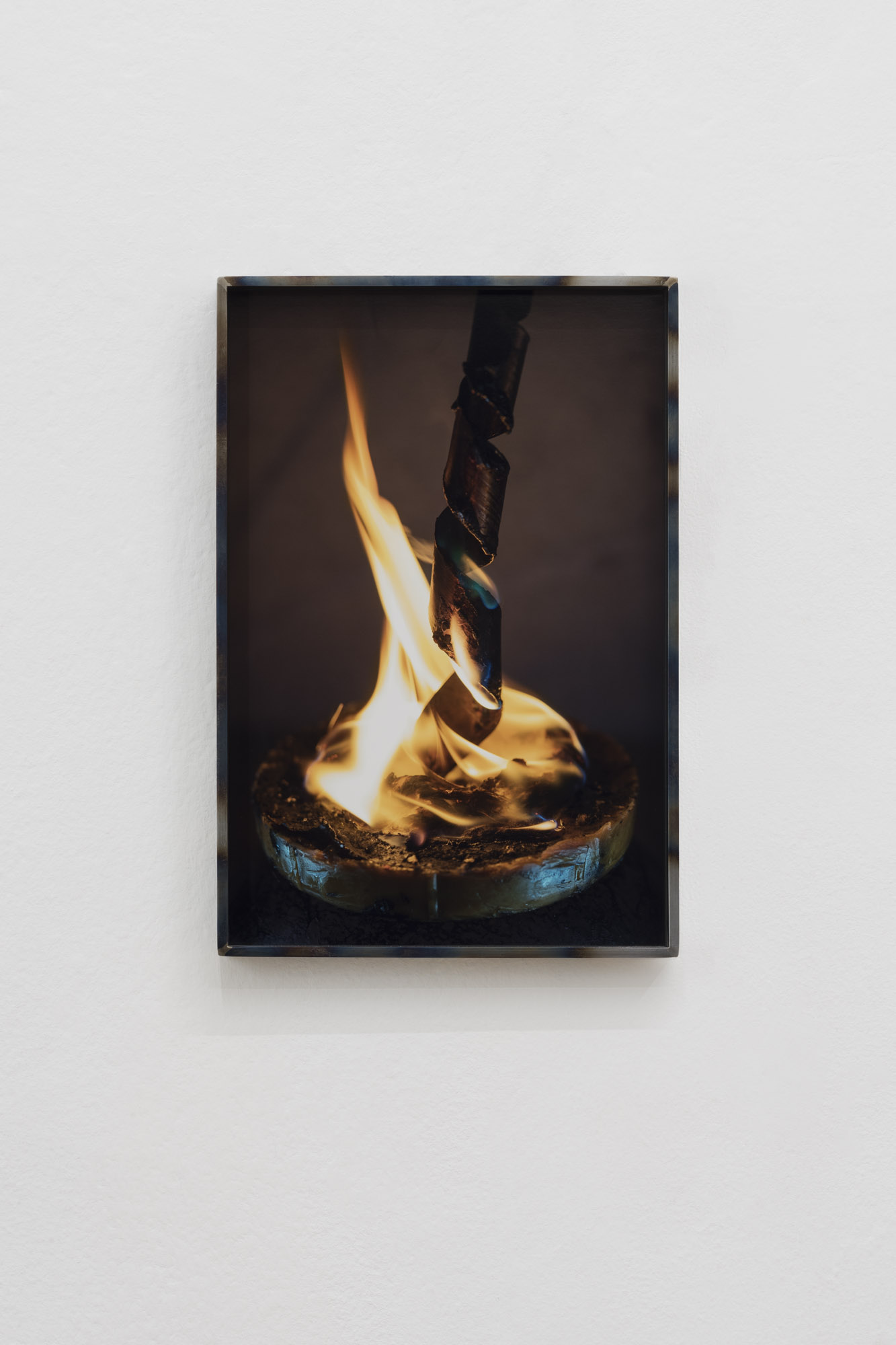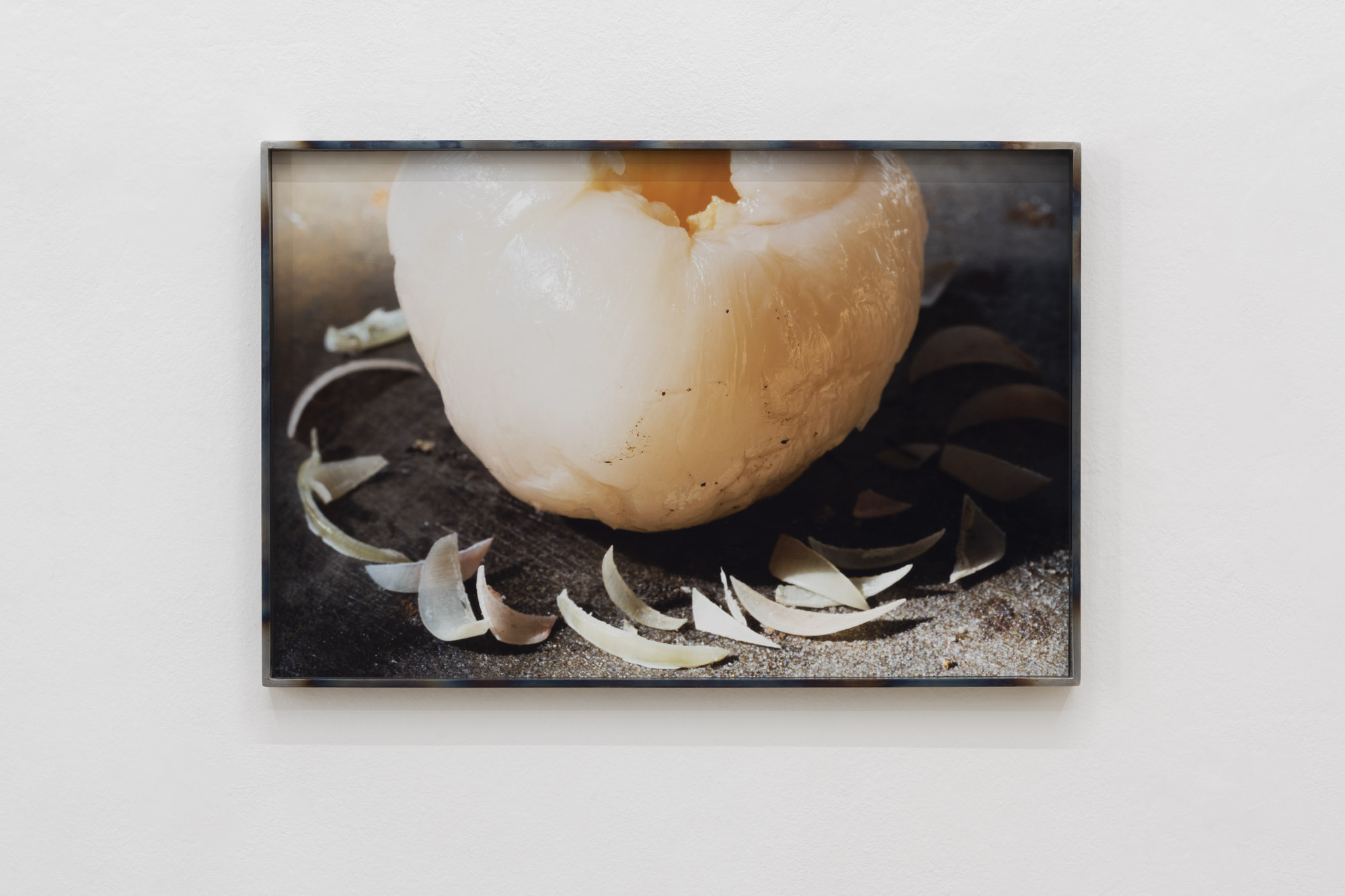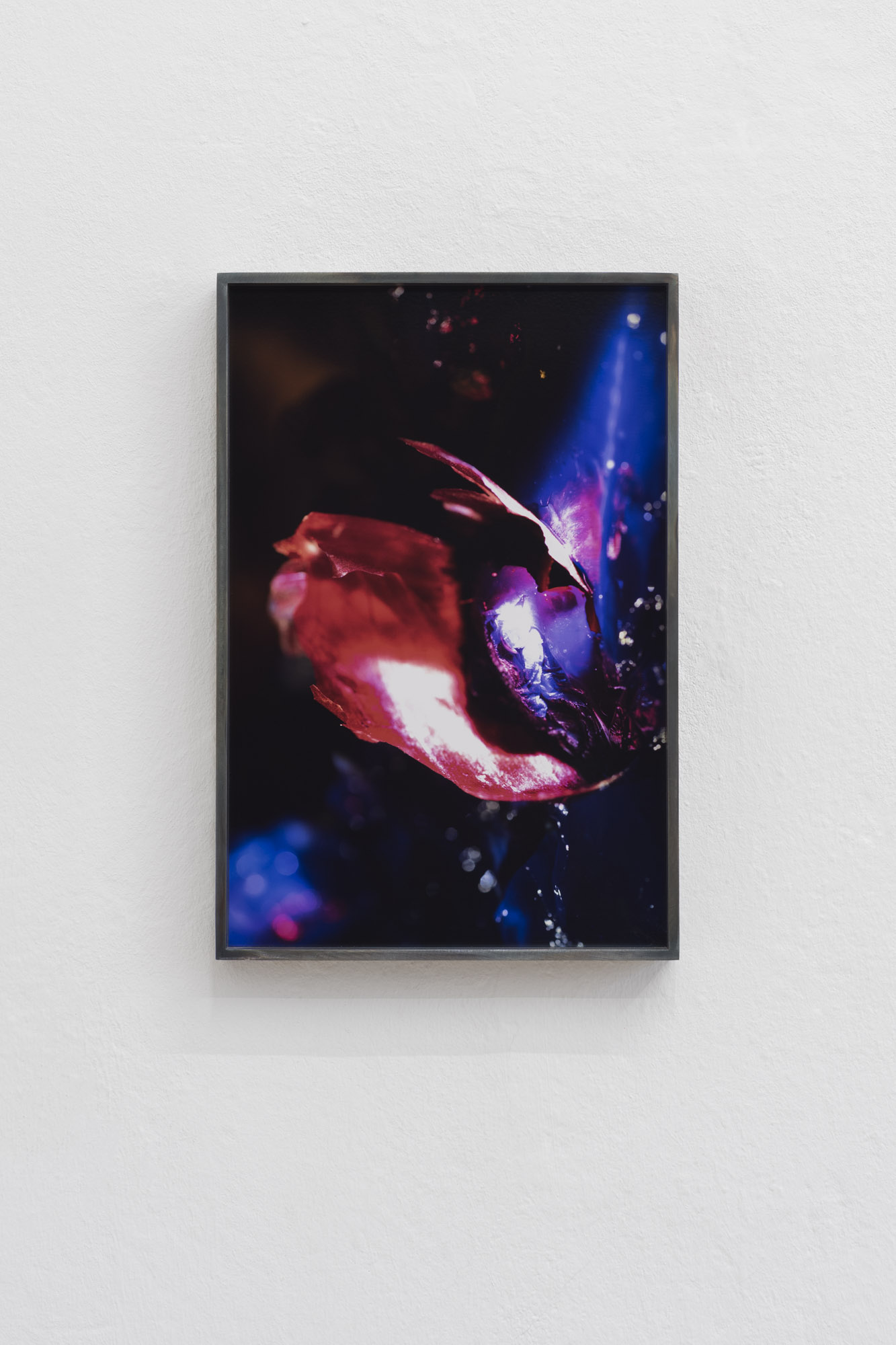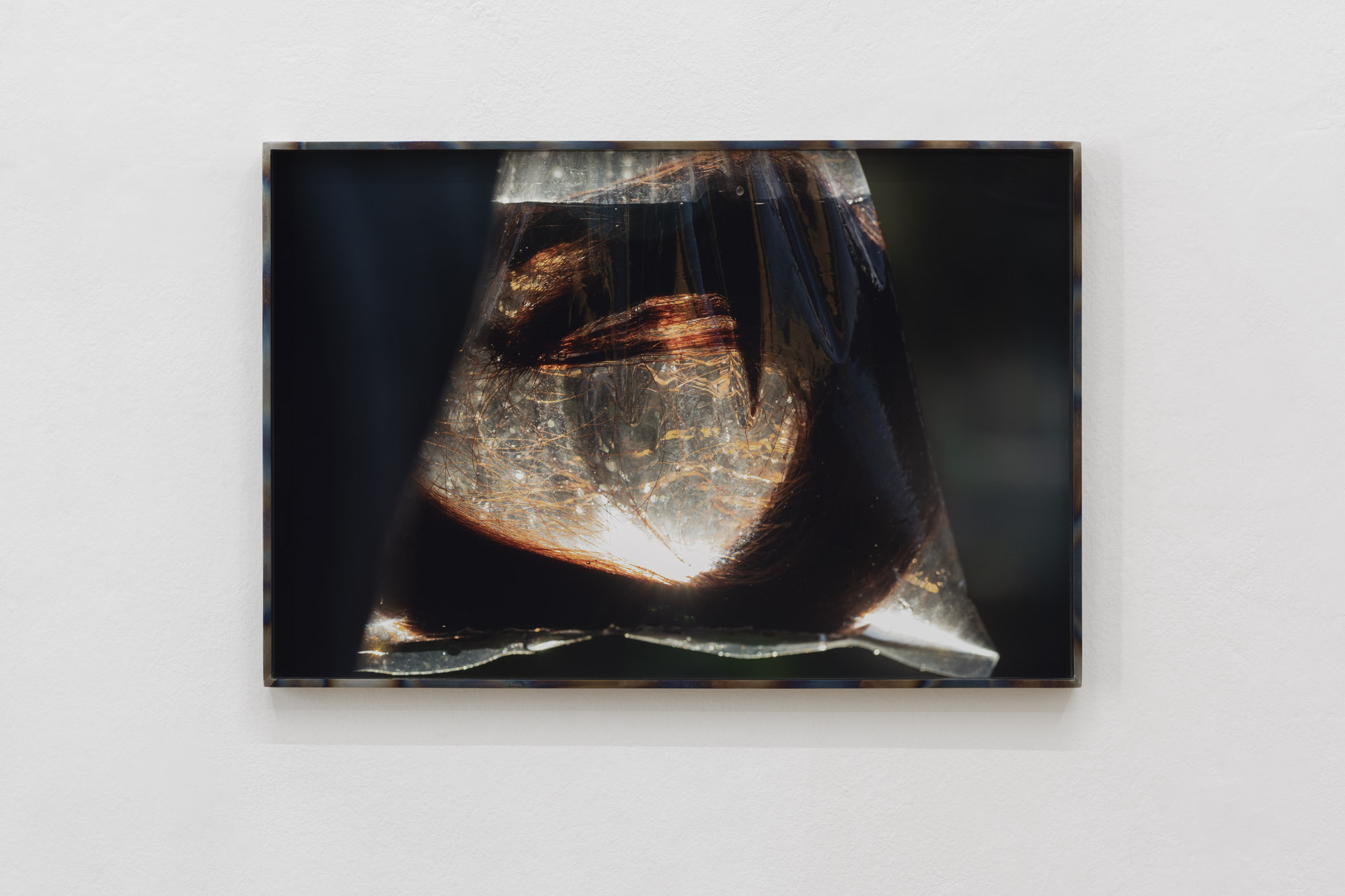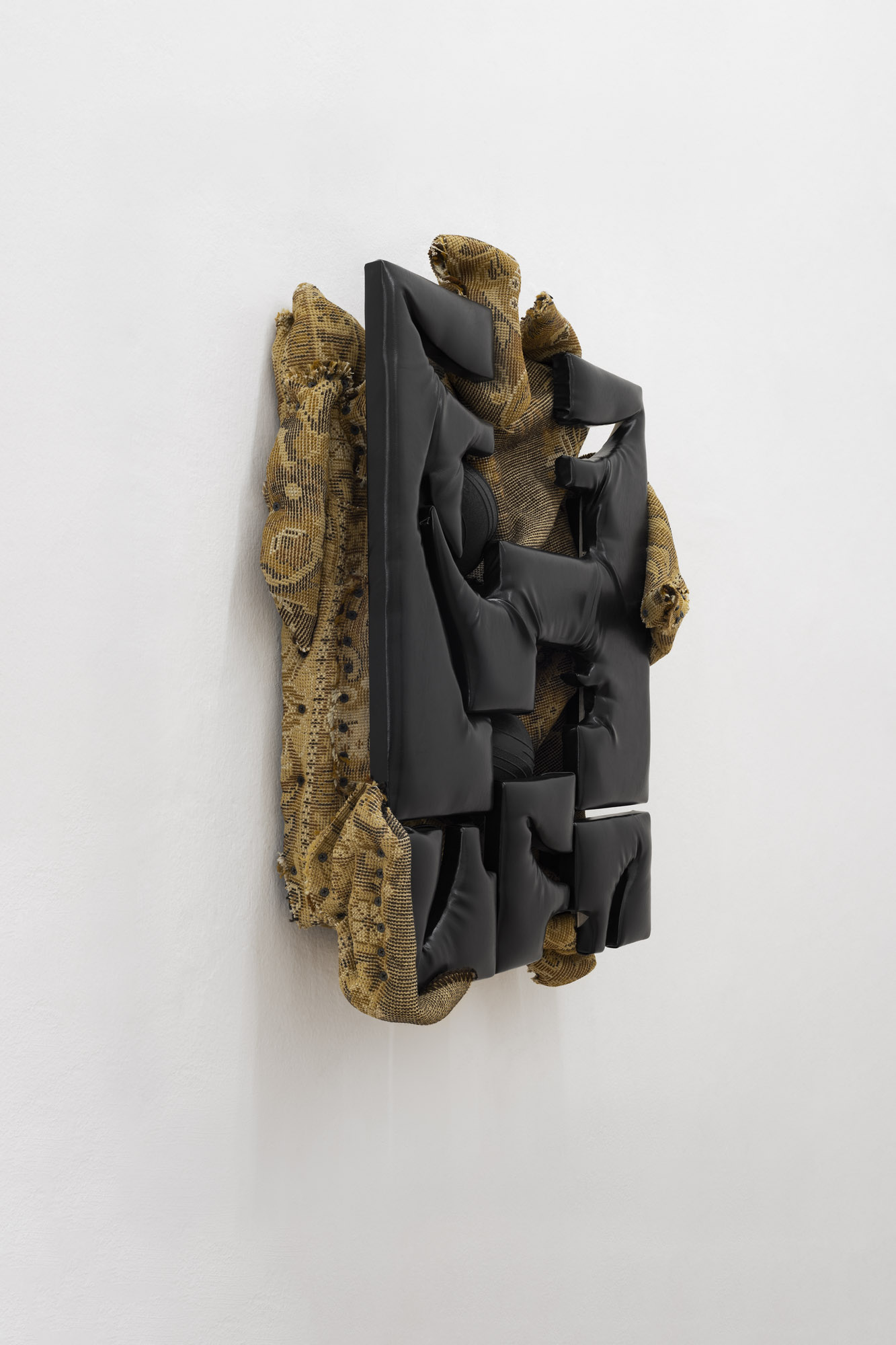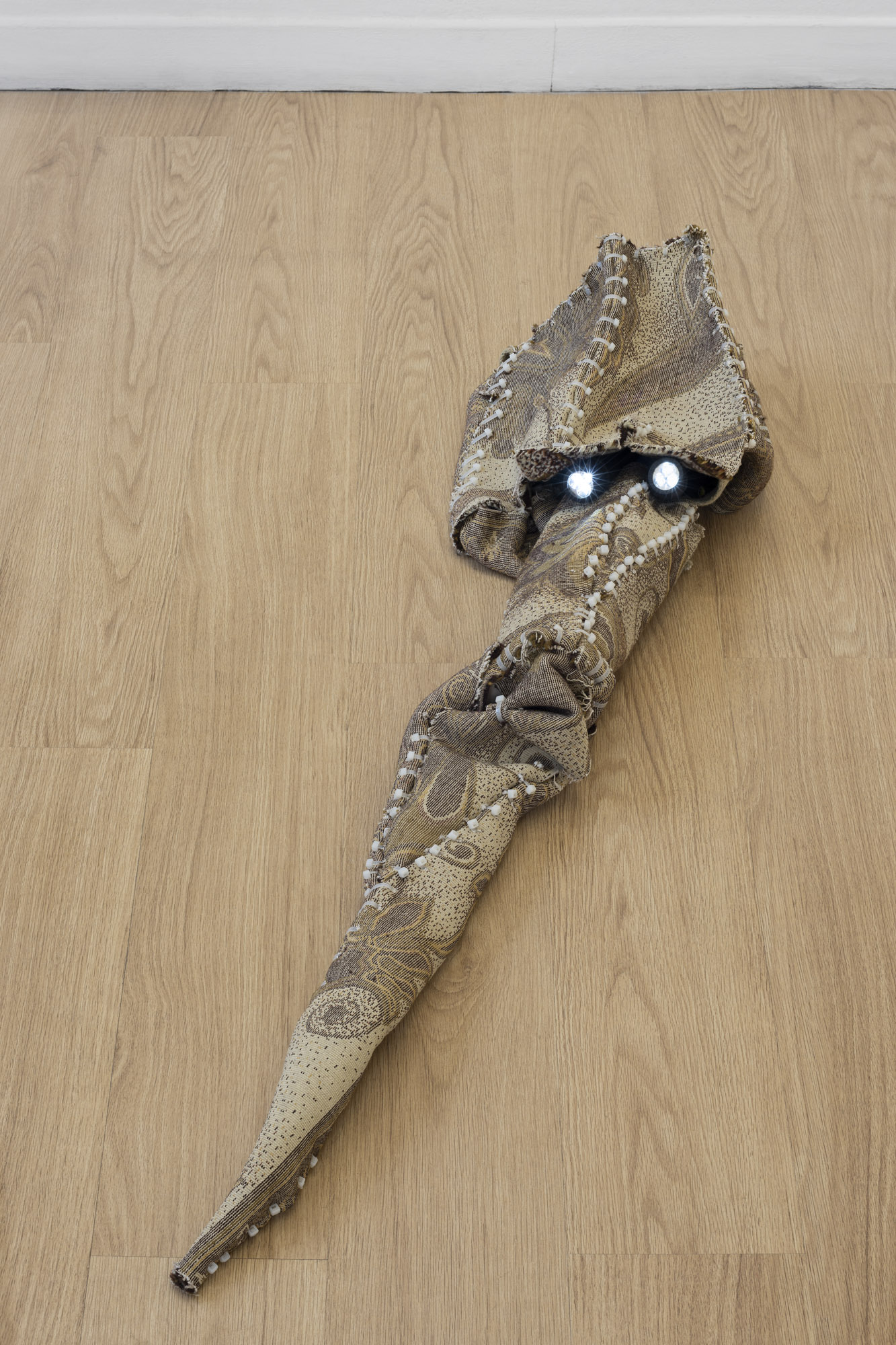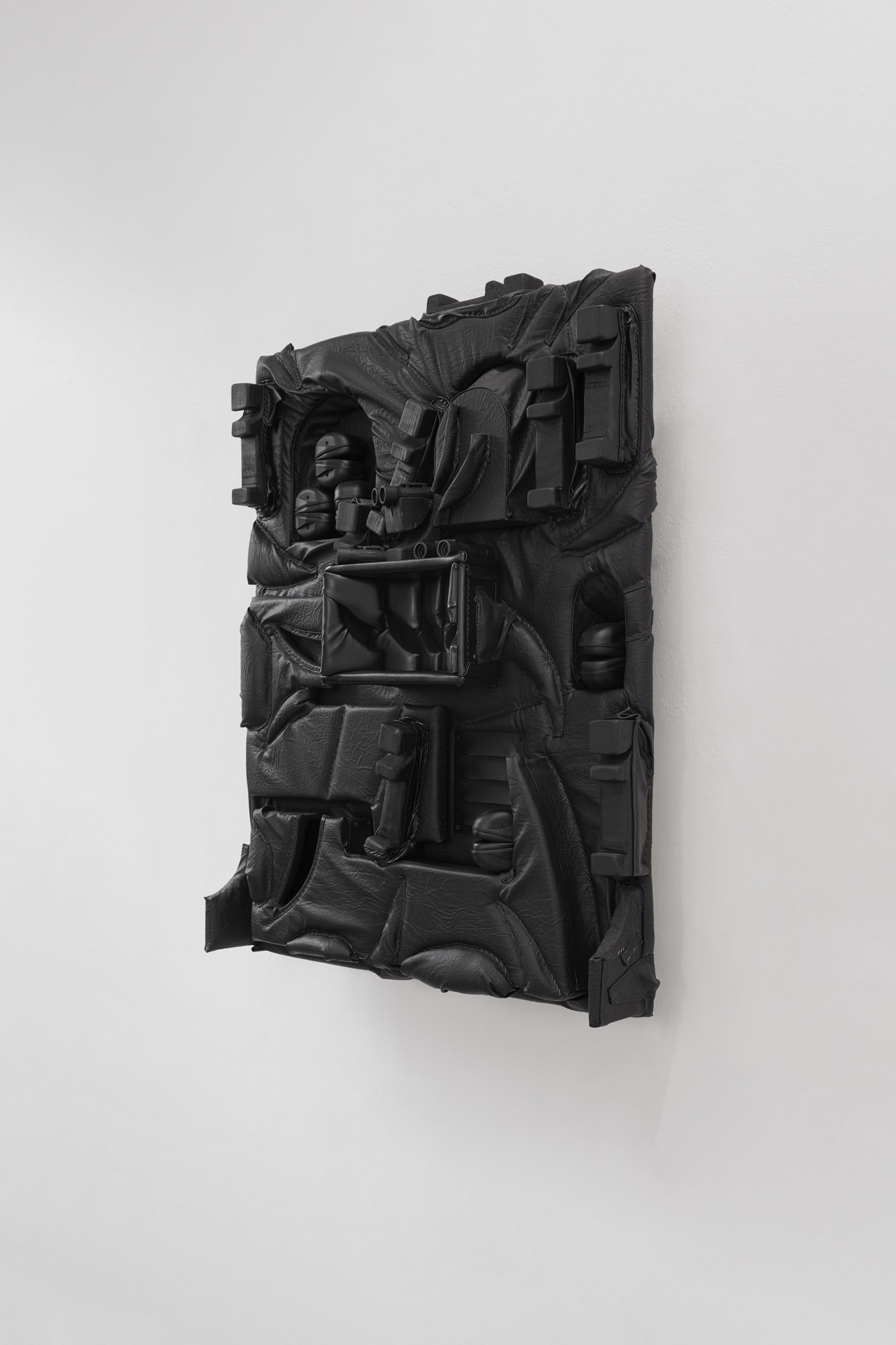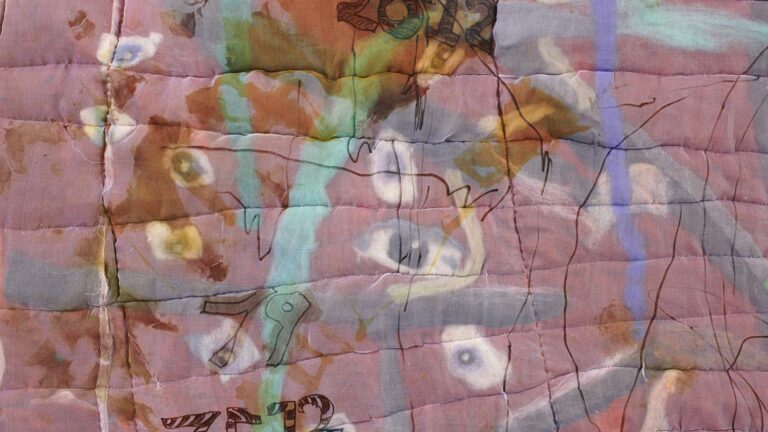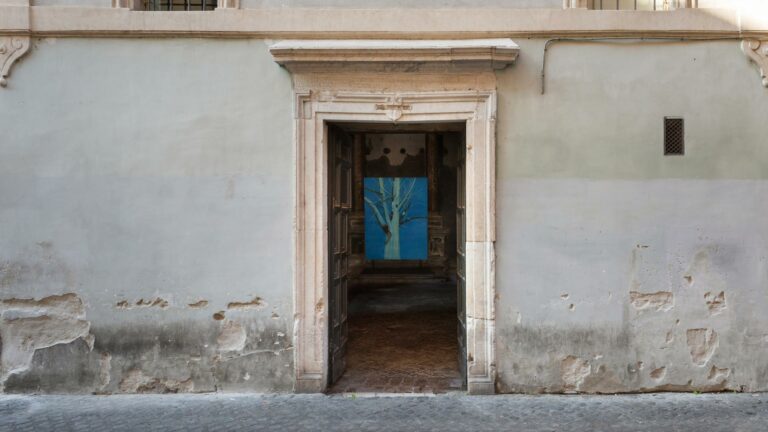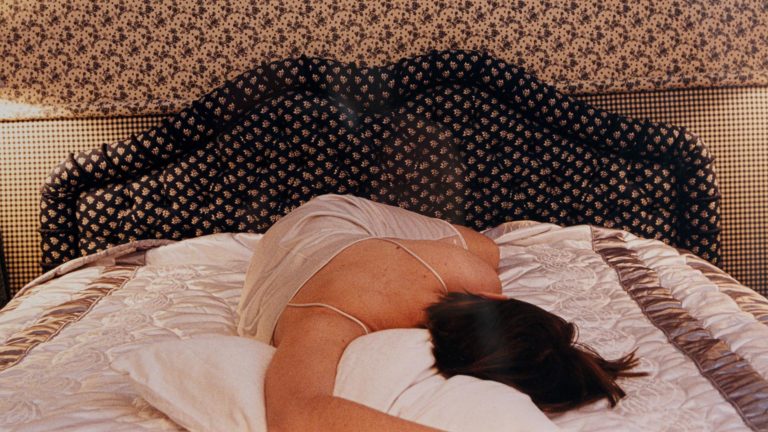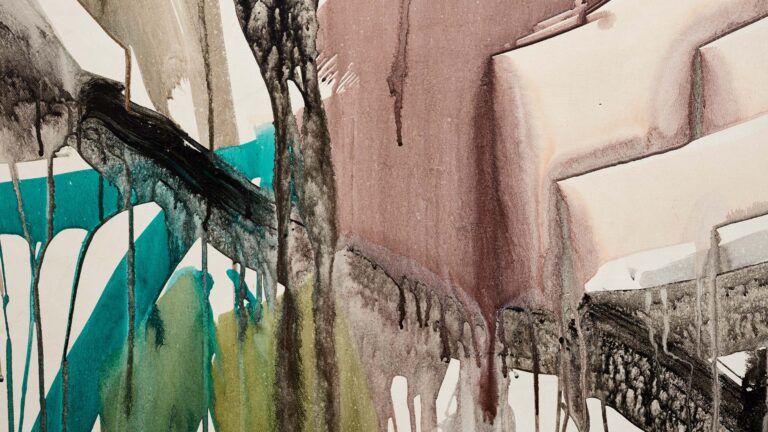Artists: Rebecca Ackroyd, Agata Ingarden, Diane Severin Nguyen, Cezary Poniatowski
Exhibition title: A Glimpse of the Setting Remains
Curated by: Giovanna Manzotti
Venue: Clima, Milan, Italy
Date: February 3 – March 22, 2022
Photography: images copyright and courtesy of the artist and Clima, Milan
What lasts and what fades over time?
A drill bit ignited by burning napalm attempts to pierce a disc, but it shrivels into a spiral folding back on itself, twisting as it does so (Wilting Helix, 2019). A massive lock of hair is suspended in a plastic bag filled with water. We imagine it thrashing around convulsively, like a goldfish in thrall to the pressures of the liquid (Liquid Isolation, 2019). A latex glove reveals the outline of a finger covered in layers of matter difficult to identify (If Revolution Is a Sickness, 2020). An injury is revealed in the porosity of its synthetic surface, showing a burn which is still hot (Her Charismatic Agony, 2020). There is always a palpable tension holding together the emotional fabric that underpins Diane Severin Nguyen’s images, a sense of suspension and destruction that manifests itself the very moment the artist captures the amalgam of materials she uses and the natural phenomena she triggers within her tight framing. It is a physical, plastic, elastic tension. A seductive and repulsive impulse that captures provisional and transforming states, invading the limits of the photographic medium itself. Nguyen’s approach to image-making is visceral; her close-up inspections reveal intimate views of scenarios that the artist recreates in her studio using elements that are as carefully juxtaposed as they are based on the ephemeral and the precarious. These are sets that could fit into the palm of your hand. “I like approaching photography as a set of limitations, and also as something problematic. It forces me to begin artmaking from a non-safe space.” Her images hybridize the organic with the synthetic and always toy with notions of abstraction: they are abject and alien mysteries, where seductive light and glossy colors deny the sense of destruction that led to their creation. That is why they are “documents,” remnants of a process of pain and pleasure, subtended as they are by an emotional and invisible architecture that manipulates us as we observe them.
Whether focused on the body in relation to its life processes or on technology as an extension of the body itself, or on the home as an element of refuge and protection, Agata Ingarden’s research is always interested in the relationship between inside and outside and in the spaces that create disorientation between a domestic sphere—“where everything is in its place”—and a wilder, growing condition—“where nothing is in its place.” Direct testimony of these are offered by Rooftop glamour and Coffee break (both 2022): two new productions conceived specifically for the exhibition and part of The hours of dog series. Like an organism that adapts and multiplies, the artist’s work expands to fill the space that constitutes it. In the works on display, the stratification and accumulation of oyster shells seems to feed the volumetric and material proliferation of the upper part of the sculpture itself. It is the proliferation of a physical, but also social and “manufactured” space, it inevitably clashes with the natural element, exploring the relationships between human beings and their inventions. Inspired by the predominantly modernist architecture that characterizes the buildings in the northern suburbs of Paris (where the artist lives and works), the inside of the sculptures consists of a skeleton framework which, once covered by the organic element, loses all architectural connotations. What remains is a small window, a glimmer of intimacy, a domestic arena of family affection. A yellow, UV light inside it pulses dimly. “Each oyster is like a flat within an expanding building; a mass but not a community; a proximity and a separation at the same time.” A cascade of office curtains serves as a support, shading and pushing the sculpture upwards. “For me, these works are like floating buildings: fleshy clouds, blinding streaks of sky, city skylines.”
Resembling a reptile lying motionless, Derealization (2020) by Cezary Poniatowski is made from an upside-down carpet sewn together with zip ties, revealing the inner part as the only visible membrane of a structureless volume. Two torches emerge from it, like binocular lenses scrutinizing the surroundings. In Domestication (2020), on the other hand, the fabric is entangled behind a composition of geometric shapes covered in synthetic leather. Two black rubber medicine balls settle between the cracks like traces of memory captured in now-invisible contours. These sculptures incorporate what may be considered the generative motifs of Poniatowski’s research: the drive towards a distorted and upside-down perspective that plays with the “prism” of memory and a sense of emptiness that refers to the sphere of the unconscious; the inclination towards “peeking” that, according to the artist, toys with our instincts, creating tension and disorientation while enhancing the wild, primordial character of the works; the evocative symbolism of the material that takes its shape in almost spectral sculptural presences. Largely informed by the cultural heritage of his native Poland, the artist’s practice makes extensive use of the blockboard, synthetic leather and upholstery foam that were once used to cover, insulate and soundproof the front doors in housing structures in the former Eastern Bloc, as well as carpets that date back to the Socialist era in Central Europe. The bas-relief Untitled (2022) radiates the sense of abandonment that for the artist originates from a “tormented craft.” Here the cavities and bulges augment the underlying anxieties of the material, blending into layers that are both aggressive and soothing. The sound dimension remains silent, as if the noise was locked inside the relief, inaudible. “My art acts as a distorting mirror that focuses on existential threads, where stories pulsate beneath the skin.” Sometimes these stories come alive with isolated, self-enclosed characters, like in Red Sand (2022), where four figures covered in red sand sit at the edge of a terracotta vase: out-of-scale witnesses to subcutaneous tension, “an almost suspenseful moment of waiting for something that doesn’t want to come.”
Like wall-mounted vents or drainage systems, Rebecca Ackroyd’s Fillet and Fingers Deep drawings (both 2020) evoke a feeling of crossing over and exploring the psychology of space as well as domestic and urban architecture in relation to “feeling” in a body and its vital functions. “I like the idea that architecture retains a sense of its past occupants.” Just like the artist’s painting and sculpture work—expressed generously in dreamlike installation environments that confront stark realities—the pastel works on display here (part of an ongoing series) are fleeting fragments of a broader conversation, traces of memories pervaded by a sense of abandonment in which an overtly feminine element shines through in both form and flesh tones against purple backgrounds. Balanced between abstraction and figuration, these works evoke and accentuate the relationship between interior and exterior spaces, and between the bodies within them: they recall portions of human skeletons and work their way into the most remote corners like domestic ruins, caught between a state of impermanence and the persistence of a personal and collective memory, between the dusty tones of pastel and the torn edges of paper. The reference to seductive hyper-femininity is instead echoed in Soft Engine 5 (2019), which offers itself to the eye as an immersion in thick locks of hair: red waves that settle against a potential landscape where a central detail opens up a fertile and almost threatening glimpse.
REBECCA ACKROYD (b. 1987, Cheltenham, UK) lives and works between Berlin and London. She received her Post Graduate Diploma in Fine Art from the Royal Academy, London and her BA from Byam Shaw School of Art London. Recent selected solo and group exhibitions include 100mph, Peres Projects, Berlin (2021); IRL (In Real Life), Timothy Taylor Gallery, London (2021); Tonguing the fence, Lock Up International, London (2020); Laid Bare, Galleri Opdahl, Stavanger (2020); Singed Lids, 15th Biennale de Lyon (2019); Underfoot, Fondazione Pomodoro, Milan (2019); The Mulch, Peres Projects, Berlin (2018); Mademoiselle, Centre Régional d’Art Contemporain Occitanie, Sète (2018); These Rotten Words, Chapter Gallery, Cardiff (2017); and The Root, Zabludowicz Collection, London (2017).
AGATA INGARDEN (b. 1994, Kraków, Poland) lives and works in Paris. She graduated from Beaux-Arts de Paris in 2018 and Cooper Union School of Art in New York in 2016. Her works have been exhibited in group exhibitions in venues such as Museum unter Tage, Bochum (2022); Palais de Tokyo, Paris (2019); Frac, île-de-France, Paris (2019); Mo.Co, La Panacee, Montpellier (2019); Silesian Museum, Katowice (2020); Nassauischer Kunstverein Wiesbaden (2020); Künstlerhaus, Vienna (2020); Kunstfort bij Vijhuizen, Netherlands (2021); Muzeum Sztuki Lodz (2021); and Art Encounters Biennial, Timișoara (2021). She had solo and two-person exhibitions: Heartache, Soft Opening, London (2019); Hot House, Berthold Pott Gallery, Cologne (2019); Dom, Piktogram Gallery, Warsaw (2018); The Future in Reverse together (with Agniezka Polska), East Contemporary, Milan (2020); Warm Welcome (with Konstantinos Kyriakopoulos), Exo Exo, Paris (2020). She got a Special Prize at the Future Generation Art Prize in 2021.
DIANE SEVERIN NGUYEN (b. 1990 Carson, CA) lives and works between Los Angeles and New York. She received her BA from Virginia Commonwealth University and an MFA from the Milton Avery Graduate School of the Arts at Bard College, Annandale-on-Hudson. Selected solo and two-person exhibitions include IF REVOLUTION IS A SICKNESS, SculptureCenter, New York (2021) and The Renaissance Society, Chicago (upcoming); Between Two Solitudes, Stereo, Warsaw (2021); Tyrant Star (online exhibition), Carnegie Museum of Art, Pittsburgh (2020); Minor twin worlds (with Brandon Ndife), Bureau, New York (2019); Reoccurring Afterlife, Empty Gallery, Hong Kong (2019); Flesh Before Body, Bad Reputation, Los Angeles (2019). Group exhibitions include Greater New York, MoMA PS1, New York (2021); Metabolic Rift, Berlin Atonal, Berlin (2021); Made in L.A. 2020: a version, Hammer Museum and The Huntington, Los Angeles (2020-21); and Bodies of Water: 13th Shanghai Biennale, Power Station of Art, Shanghai (2021).
CEZARY PONIATOWSKI (b. 1987, Olsztyn, Poland) lives and works in Warsaw. In 2012 he graduated from the Academy of Fine Arts in Warsaw where he received his MFA. His recent solo shows include Relief, Basilica di San Celso, Milan (2021); Vaults and Swellings, FUTURA – Centre for Contemporary Art, Prague (2021); Welcome to Itchy Truths, Stereo, Warsaw (2020); Hearth, Jan Kaps, Cologne (2020); Hereafter (with Sami Schlichting), Mélange, Cologne (2019). His recent group shows include Metabolic Rift, Berlin Atonal, Berlin (2021); All Worlds Are Flat, Blindside, Melbourne (2021); The Spirit of Nature and Other Fairy Tales. 20 years of The ING Polish Art Foundation, Silesian Museum, Katowice (2019); Nosztrómo, Ashes/Ashes, New York (2019); Waiting for Another Coming, Centre for Contemporary Art Ujazdowski Castle, Warsaw (2018); Doors of Paradise, Union Pacific, London (2018); and FOAF Berlin (Friend of a Friend), ChertLüdde, Berlin (2018).
A Glimpse of the Setting Remains curated by Giovanna Manzotti at Clima, Milan Exhibition view Photo: Marco Davolio Courtesy: Clima
A Glimpse of the Setting Remains curated by Giovanna Manzotti at Clima, Milan Exhibition view Photo: Marco Davolio Courtesy: Clima
A Glimpse of the Setting Remains curated by Giovanna Manzotti at Clima, Milan Exhibition view Photo: Marco Davolio Courtesy: Clima
A Glimpse of the Setting Remains curated by Giovanna Manzotti at Clima, Milan Exhibition view Photo: Marco Davolio Courtesy: Clima
Rebecca Ackroyd, Soft Engine, 2019, Gouache, charcoal and soft pastel on Somerset satin paper, 102×54 cm, Courtesy: Peres Projects, Berlin
Rebecca Ackroyd, Fingers deep, 2020, Gouache, soft pastel on Somerset satin paper, 68×41cm, Courtesy: Peres Projects, Berlin
Rebecca Ackroyd, Fillet, 2020, Gouache, soft pastel on Somerset satin paper, 41 × 36 cm, Courtesy: Peres Projects, Berlin
Agata Ingarden, Coffee Break, 2022, Stainless steel, oyster shells, glue, wires, neon bulbs, plastic window model, double sided mirror, blinds, 195 × 38 × 45 cm, Courtesy: the artist
Agata Ingarden, Coffee Break, 2022, Stainless steel, oyster shells, glue, wires, neon bulbs, plastic window model, double sided mirror, blinds, 195 × 38 × 45 cm, Courtesy: the artist
Agata Ingarden, Rooftop Glamour, 2022, Stainless steel, oyster shells, glue, wires, neon bulbs, plastic window model, double sided mirror, blinds, 200 × 47 × 29 cm, photo: Marco Davolio, Courtesy: the artist
Agata Ingarden, Rooftop Glamour, 2022, Stainless steel, oyster shells, glue, wires, neon bulbs, plastic window model, double sided mirror, blinds, 200 × 47 × 29 cm, photo: Marco Davolio, Courtesy: the artist
Diane Severin Nguyen, Wilting Helix , 2019, LightJet C-print, metal frame, 38,10 × 25,40 cm, Courtesy: the artist and Bureau, New York
Diane Severin Nguyen, An era where war became a memory, 2018, LightJet C-print, metal frame, 38,10 × 57,15 cm, Courtesy: the artist and Bureau, New York
Diane Severin Nguyen, Her Charismatic Agony, 2019, LightJet C-print, metal frame, 38,10 × 25,40 cm, Courtesy: the artist and Bureau, New York
Diane Severin Nguyen, If Revolution is a Sickness, 2020, LightJet C-print, metal frame, 38,10 × 25,40 cm, Courtesy: the artist and Bureau, New York
Diane Severin Nguyen, Feel how your breath enlarges all space, 2019, LightJet C-print, steel frame, 38,10 x 25,40 cm, Courtesy: the artist and Bureau, New York
Diane Severin Nguyen, Liquid Isolation, 2019, LightJet C-print, metal frame, 38,10 × 57,15 cm, Courtesy: the artist and Bureau, New York
Cezary Poniatowski, Domestication, 2020, Pleather, upholstery foam, blockboard, carpet, screws, rubber medicine balls, 72 × 59 × 18 cm, Courtesy: the artist
Cezary Poniatowski, Domestication, 2020, Pleather, upholstery foam, blockboard, carpet, screws, rubber medicine balls, 72 × 59 × 18 cm, Courtesy: the artist
Cezary Poniatowski, Derealization, 2020, Carpet, zip ties, flashlights, 32 × 142 × 23 cm, Courtesy: the artist
Cezary Poniatowski, Untitled, 2022, Pleather, plywood, upholstery foam, anti-noise earmuffs, staples, binoculars, 125 × 100 × 20 cm, Courtesy: the artist
Cezary Poniatowski, Untitled, 2022, Pleather, plywood, upholstery foam, anti-noise earmuffs, staples, binoculars, 125 × 100 × 20 cm, Courtesy: the artist
Cezary Poniatowski, Red Sand, 2022, Red desert sand, flower pots, 38×27×25cm, Courtesy: the artist


